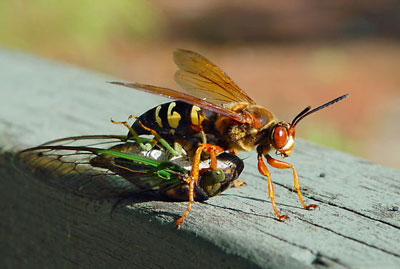Question of the Week #2: August 11, 2016

Cicada killer with its prey
I don’t have a great photo like the one above showing a cicada killer attacking a cicada. Extension entomologists taught me about this insect early in my career, so it’s only fitting to use their photo and give them full credit. Thanks to Texas AgriLife Extension Entomology.
“Neil, we have these large wasps that hover around the ground while we’re out in the yard. What are they, and how can we kill them?”
You’re seeing cicada killers, also known as ground wasps. They are basically beneficial and are usually harmless unless provoked. They are pollinators, but they are also predators. The adult females hover near the ground watching and listening for cicadas. This time of year your ears will tell you that there’s a steady supply.
Suddenly, the buzz of a hundred cicadas is broken by a loud racquet roughly akin to the sound of a handful of bolts thrown into an electric fan. You jerk your head to see what’s going on, and you see the cicada killer riding the hapless cicada to the ground. Once she is there and is sure that her prey is fully paralyzed, the wasp lifts off, prey in tow, and carries it back to her tunnel. She pushes it down into the tunnel, deposits one egg in the carcass and seals off the tunnel. The egg hatches, the larva develops within the cicada over the winter, pupates and emerges the following spring as the adult cicada killer to start the cycle all over again.
But in the meantime, you are amazed. And relieved as you’re released from your assignment to worry.
Here is a good reference from Texas A&M entomologists.
